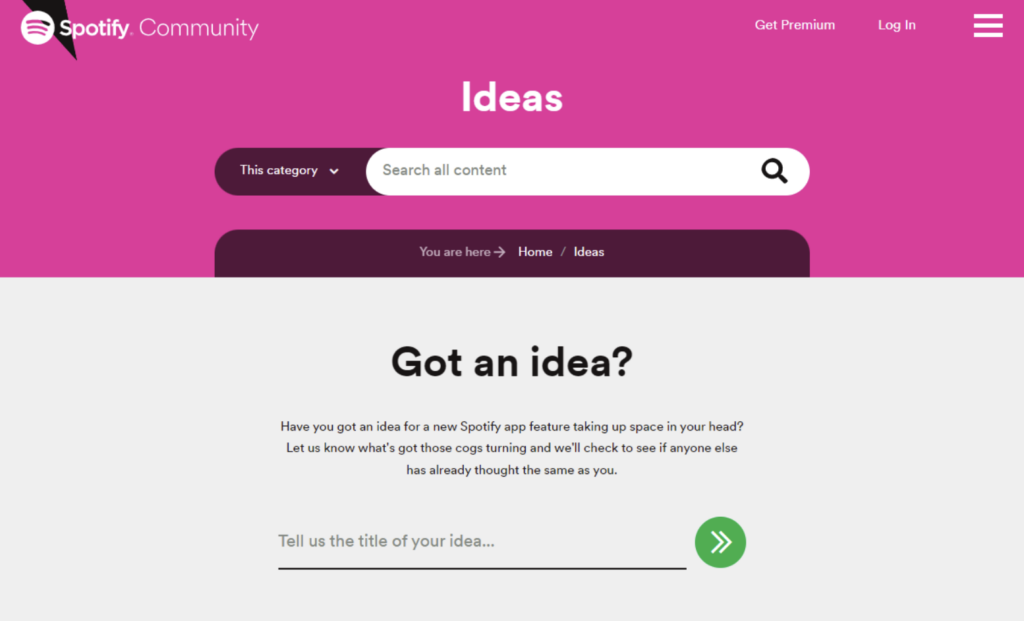3 Reasons To Rethink Your Customer Idea Portal
Any good product manager will tell you that a big part of their job is forming a deep understanding of customer needs. User idea suggestion portals are a helpful tool in doing that, but they might not be the best (or only) one for the job.

What Are Idea Portals And How Do They Work?
UserVoice popularized the concept in 2008, but now there are many providers of idea management software, used by companies like Spotify, Airbnb, and Microsoft.
Most feature idea portals have the same core mechanics:
- Users visit a dedicated website with a list of feature ideas from other users (and sometimes the company itself)
- Users can submit their ideas or vote and comment on existing ideas
- Administrators review submissions, prioritize them, and publicly communicate their status to the users

The premise of an idea portal is terrific — instead of product managers having to scratch their heads as to what features their team should build, why not let users themselves spell out what they need? Then have them prioritize ideas through voting, and from there it’s just a matter of picking the top ones for implementation.
But does this user-led workflow provide the best guide for your product development?
Related Article: How Support Tagging Boosts Product-Support Collaboration
Three Problems With Idea Portals
1. Asking Users To Prioritize Your Product Roadmap
Because the idea portal is a public forum, the implicit contract is that for investing time in suggesting a new product idea users at least deserve a thoughtful response from the product team. This adds administrative overhead for you, but that’s not the worst part.
If hundreds of users upvote an idea, it adds further pressure on you to implement the idea. Lucky you if the suggestion happens to align with your business and product strategy.
If not — you’re on the defense trying to rationalize to hundreds of users why you aren’t going to implement a popular idea. Suddenly, you’re faced with the tough dilemma of breaching user trust and admitting that you might not be as “customer-centric” as you made it seem or allowing the most vocal of your users to steer your roadmap.
2. Asking Users To Design Your Product
The way idea portals frame suggestions forces users to think in terms of solutions. This puts the user in the role of a product designer where they are expected to conceptualize, design, and describe a solution that will improve your product or service.
It’s fair to say that most users aren’t qualified for this task and don’t have the same context as your team. Most proposed feature ideas will frustrate your designers and engineers because they’ll lack the right context around the underlying problems that you need to know.
3. Prioritizing Based On Votes
Because feature idea lists are often ordered by the number of votes, it might be tempting to prioritize feature idea suggestions by the number of votes they attracted. If many people vote on an idea, then surely there must be many people who need it. The problem with this approach is that not all votes are created equal.
First, on idea portals, votes don’t come with any indication of how strong the user’s need is. It could range anywhere from “nice to have” to “my life depends on it.” A vote is a vote.
Second, votes might carry different weights depending on your product strategy. For example, if your quarterly goal is to decrease the churn of paying customers, you want to identify what missing functionality might be causing churn. It doesn’t matter if hundreds of free users vote on a suggestion if it has nothing to do with the needs of your paying customers.
Related Article: What Is Customer Sentiment Analysis — And Why Is It Important?
A Better Alternative To Idea Portals
1. Set The Right Expectations
When launching your idea forum, avoid setting the expectation that you will respond to every request or that you will implement the most popular ideas. Highlight that while you consider customer suggestions, every feature has to go through a rigorous process of research, prototyping, validation, design, engineering, and testing to make sure that only the most valuable features are implemented. This will free you to make decisions that are aligned with your product strategy.
2. Focus On Customer Problems
Users are the ultimate experts in their own problems — the solutions are up to you. You need to make sure that you are capturing their needs and pain points from every idea suggestion.
You can encourage this by formatting your idea submission forms to focus on the following questions:
- What is the problem you’re experiencing?
- Describe the last time you encountered this problem.
- How will you know if this problem is solved?
- How will your life improve if it’s solved?
3. Segment Your Reports
Make sure that you have key customer metadata recorded against their idea suggestions so that you can segment it into meaningful buckets. The types of metadata you track will depend on what distinguishes your customers. It might be their job title, company size, plan type, or monthly activity. This will allow you to identify ideas that pertain to customer segments you care about serving and weed others out.
4. Mix In Other Data Sources
Instead of treating your idea portal as the only source of truth for customer needs, treat it as one of the inputs into your customer research process.
Depending on your business, you might have access to customer support tickets, sales conversations, user reviews, survey responses, UX interviews, and many other channels. Many of these channels collect data in a way that’s less biased than idea portals, and when combined and analyzed, will give you a much broader overview of your user needs.
5. Automate The Analysis
With the advancements in natural language processing (NLP) technology and machine learning in general, automating the analysis of unstructured customer feedback is becoming more and more accessible.
Given the increasingly large volumes of customer feedback that businesses are gathering from various sources, it makes sense to make sure that every piece is analyzed and learned from.
A solution like Playvox Customer AI is a comprehensive way of assembling and analyzing customer feedback for themes and sentiment at scale.
Related Article: How To Properly Tag Chat Conversations — And Why It’s Essential
Look For Feedback Everywhere You Can
When used with care, idea portals can be a fantastic source of customer feedback, and it’s a positive customer experience when your users feel like they have a voice. However, the subtle ways in which idea portals can mislead and misinform product leaders are worth noting. Instead, find ways to balance customer ideas with other customer feedback to create a profitable product development roadmap for your solution.







